

A staple food, food staple, or simply staple, is a food that is eaten often and in such quantities that it constitutes a dominant portion of a standard diet for an individual or a population group, supplying a large fraction of energy needs and generally forming a significant proportion of the intake of other nutrients as well.[1] For humans, a staple food of a specific society may be eaten as often as every day or every meal, and most people live on a diet based on just a small variety of food staples.[2] Specific staples vary from place to place, but typically are inexpensive or readily available foods that supply one or more of the macronutrients and micronutrients needed for survival and health: carbohydrates, proteins, fats, minerals, and vitamins.[1] Typical examples include grains (cereals and legumes), seeds, nuts and root vegetables (tubers and roots). Among them, cereals (rice, wheat, oat, maize, etc.), legumes (lentils and beans) and tubers (e.g. potato, taro and yam) account for about 90% of the world's food calorie intake.[1]
Early agricultural civilizations valued the crop foods that they established as staples because, in addition to providing necessary nutrition, they generally are suitable for storage over long periods of time without decay. Such nonperishable foods are the only possible staples during seasons of shortage, such as dry seasons or cold temperate winters, against which times harvests have been stored. During seasons of surplus, wider choices of foods may be available.
Type
Staple foods are derived from either plant or animal products that are digestible by humans and can be supplied in substantial quantities. Common plant-based staples include cereals (e.g. rice, wheat, maize, millet, barley, oats, rye, spelt, emmer, triticale and sorghum), starchy tubers (e.g. potato, sweet potato, yam and taro) or root vegetables (e.g. cassava, turnip, carrot, rutabagas), and dried legumes (lentils and beans).[3] Animal-based staples include various types of meat (typically livestock and poultry), fish, eggs, milk and dairy products (e.g. cheese).[2] Other staple foods include sago (derived from the pith of the sago palm tree),[4] and large, fleshy fruits (e.g. breadfruit, breadnut, coconut and plantains). Staple foods may also include processed food products (depending on the region) such as olive oil, coconut oil, and sugar.[5][6][7]
Demographics


The dominant staple foods in different parts of the world are a function of weather patterns, local terrain, farming constraints, acquired tastes and ecosystems. For example, the main energy source staples in the average African diet are cereals (46 percent), roots and tubers (20 percent) and animal products (7 percent). In Western Europe the main staples in the average diet are animal products (33 percent), cereals (26 percent), and roots and tubers (4 percent).
Most of the human population lives on a diet based on one or more of the following staples: cereals (rice, wheat, maize (corn), millet, and sorghum), roots and tubers (potatoes, cassava, yams and taro), and animal products such as meat, milk, eggs, cheese and fish. Regional staples include the plants rye, soybeans, barley, oats, and teff.
Just 15 plant crops provide 90 percent of the world's food energy intake (exclusive of meat), with rice, maize, and wheat comprising 2/3 of human food consumption. These three are the staples of about 80 percent of the world population,[8] and rice feeds almost half of humanity.
Roots and tubers, meanwhile, are important staples for over one billion people in the developing world, accounting for roughly 40 percent of the food eaten by half the population of sub-Saharan Africa. Roots and tubers are high in carbohydrates, calcium, and vitamin C, but low in protein. Cassava root, for example, is a major food staple in the developing world, a basic food source for around 500 million people.
With economic development and free trade, many countries have shifted away from low-nutrient-density staple foods to higher-nutrient-density staples, as well as towards greater meat consumption.
Some foods like quinoa—a pseudocereal grain that originally came from the Andes—were also staples centuries ago.[9] Oca tubers, ulluku tubers and grain amaranth are other foods that may have been historical Andean staples.[10] Pemmican made from dried meat and fat was a staple of the Plains Indians of North America.[11]
Production
Most staple food is currently produced using modern, conventional farming practices. However, the production of staple food using organic farming methods is growing.
| World production, 2012[13] | Average world yield, 2010 | World's most productive countries,[14] 2012[15] |
World's largest producing countries,
2013[16] | ||||
|---|---|---|---|---|---|---|---|
| Rank | Crop | (metric tons) | (tons per hectare) | (tons per hectare) | Country | (metric tons) | Country |
| 1 | Maize (Corn) | 873 million | 5.1 | 11.1[17] | United States | 354 million | United States |
| 2 | Rice | 738 million | 4.3 | 9.5 | Egypt | 204 million | China |
| 3 | Wheat | 671 million | 3.1 | 8.9 | New Zealand | 122 million | China |
| 4 | Potatoes | 365 million | 17.2 | 45.4 | Netherlands | 96 million | China |
| 5 | Cassava | 269 million | 12.5 | 34.8 | Indonesia | 47 million | Nigeria |
| 6 | Soybeans | 241 million | 2.4 | 4.4 | Egypt | 91 million | United States |
| 7 | Sweet potatoes | 108 million | 13.5 | 33.3 | Senegal | 71 million | China |
| 8 | Yams | 59.5 million | 10.5 | 28.3 | Colombia | 36 million | Nigeria |
| 9 | Sorghum | 57.0 million | 1.5 | 4.5 | United States | 10 million | United States |
| 10 | Plantain | 37.2 million | 6.3 | 31.1 | El Salvador | 9 million | Uganda |
Processing
Rice is most commonly cooked and eaten as separate entire grains, but most other staple cereals are milled into a flour or meal that can be used to make bread, noodles, pasta, porridge and mushes like mealie pap. Root vegetables can be mashed and used to make porridge-like dishes such as poi and fufu. Pulses (such as chickpeas, from which gram flour is made) and starchy root vegetables (such as canna rhizomes) can also be made into flour.
Nutrition
Consumed in isolation, staple foods do not provide the full range of essential nutrients. The nutrient-deficiency disease pellagra is associated with a diet consisting primarily of maize, while the disease beriberi is associated with a diet of refined white rice.[18] Scurvy can result from a lack of vitamin C, also known as ascorbic acid. One author indicated that the nutritional value of some staple foods are negatively affected by higher levels of carbon dioxide, as occurs in climate change.[19]
Comparison of 10 staple foods
The following table shows the nutrient content of 10 major staple vegetable foods in raw form on a dry weight basis to account for their different water contents. Raw grains are not edible and cannot be digested, so must be cooked, sprouted, or otherwise prepared for human consumption. In sprouted and cooked form, the relative nutritional and anti-nutritional contents of each of these grains is different from that of the raw form of these grains, as shown. Potatoes also must be cooked, but should not be sprouted. The highlighted values show the highest nutrient density among these 10 staples. Other foods, consumed in smaller quantities, may have nutrient densities different from these values.
| Staple | Maize (corn)[A] | Rice, white[B] | Wheat[C] | Potatoes[D] | Cassava[E] | Soybeans, green[F] | Sweet potatoes[G] | Yams[Y] | Sorghum[H] | Plantain[Z] | RDA |
|---|---|---|---|---|---|---|---|---|---|---|---|
| Water content (%) | 10 | 12 | 13 | 79 | 60 | 68 | 77 | 70 | 9 | 65 | |
| Raw grams per 100 g dry weight | 111 | 114 | 115 | 476 | 250 | 313 | 435 | 333 | 110 | 286 | |
| Nutrient | |||||||||||
| Energy (kJ) | 1698 | 1736 | 1574 | 1533 | 1675 | 1922 | 1565 | 1647 | 1559 | 1460 | 8,368–10,460 |
| Protein (g) | 10.4 | 8.1 | 14.5 | 9.5 | 3.5 | 40.6 | 7.0 | 5.0 | 12.4 | 3.7 | 50 |
| Fat (g) | 5.3 | 0.8 | 1.8 | 0.4 | 0.7 | 21.6 | 0.2 | 0.6 | 3.6 | 1.1 | 44–77 |
| Carbohydrates (g) | 82 | 91 | 82 | 81 | 95 | 34 | 87 | 93 | 82 | 91 | 130 |
| Fiber (g) | 8.1 | 1.5 | 14.0 | 10.5 | 4.5 | 13.1 | 13.0 | 13.7 | 6.9 | 6.6 | 30 |
| Sugar (g) | 0.7 | 0.1 | 0.5 | 3.7 | 4.3 | 0.0 | 18.2 | 1.7 | 0.0 | 42.9 | minimal |
| Minerals | [A] | [B] | [C] | [D] | [E] | [F] | [G] | [Y] | [H] | [Z] | RDA |
| Calcium (mg) | 8 | 32 | 33 | 57 | 40 | 616 | 130 | 57 | 31 | 9 | 1,000 |
| Iron (mg) | 3.01 | 0.91 | 3.67 | 3.71 | 0.68 | 11.09 | 2.65 | 1.80 | 4.84 | 1.71 | 8 |
| Magnesium (mg) | 141 | 28 | 145 | 110 | 53 | 203 | 109 | 70 | 0 | 106 | 400 |
| Phosphorus (mg) | 233 | 131 | 331 | 271 | 68 | 606 | 204 | 183 | 315 | 97 | 700 |
| Potassium (mg) | 319 | 131 | 417 | 2005 | 678 | 1938 | 1465 | 2720 | 385 | 1426 | 4700 |
| Sodium (mg) | 39 | 6 | 2 | 29 | 35 | 47 | 239 | 30 | 7 | 11 | 1,500 |
| Zinc (mg) | 2.46 | 1.24 | 3.05 | 1.38 | 0.85 | 3.09 | 1.30 | 0.80 | 0.00 | 0.40 | 11 |
| Copper (mg) | 0.34 | 0.25 | 0.49 | 0.52 | 0.25 | 0.41 | 0.65 | 0.60 | - | 0.23 | 0.9 |
| Manganese (mg) | 0.54 | 1.24 | 4.59 | 0.71 | 0.95 | 1.72 | 1.13 | 1.33 | - | - | 2.3 |
| Selenium (μg) | 17.2 | 17.2 | 81.3 | 1.4 | 1.8 | 4.7 | 2.6 | 2.3 | 0.0 | 4.3 | 55 |
| Vitamins | [A] | [B] | [C] | [D] | [E] | [F] | [G] | [Y] | [H] | [Z] | RDA |
| Vitamin C (mg) | 0.0 | 0.0 | 0.0 | 93.8 | 51.5 | 90.6 | 10.4 | 57.0 | 0.0 | 52.6 | 90 |
| Thiamin (B1) (mg) | 0.43 | 0.08 | 0.34 | 0.38 | 0.23 | 1.38 | 0.35 | 0.37 | 0.26 | 0.14 | 1.2 |
| Riboflavin (B2) (mg) | 0.22 | 0.06 | 0.14 | 0.14 | 0.13 | 0.56 | 0.26 | 0.10 | 0.15 | 0.14 | 1.3 |
| Niacin (B3) (mg) | 4.03 | 1.82 | 6.28 | 5.00 | 2.13 | 5.16 | 2.43 | 1.83 | 3.22 | 1.97 | 16 |
| Pantothenic acid (B5) (mg) | 0.47 | 1.15 | 1.09 | 1.43 | 0.28 | 0.47 | 3.48 | 1.03 | - | 0.74 | 5 |
| Vitamin B6 (mg) | 0.69 | 0.18 | 0.34 | 1.43 | 0.23 | 0.22 | 0.91 | 0.97 | - | 0.86 | 1.3 |
| Folate Total (B9) (μg) | 21 | 9 | 44 | 76 | 68 | 516 | 48 | 77 | 0 | 63 | 400 |
| Vitamin A (IU) | 238 | 0 | 10 | 10 | 33 | 563 | 4178 | 460 | 0 | 3220 | 5000 |
| Vitamin E, alpha-tocopherol (mg) | 0.54 | 0.13 | 1.16 | 0.05 | 0.48 | 0.00 | 1.13 | 1.30 | 0.00 | 0.40 | 15 |
| Vitamin K1 (μg) | 0.3 | 0.1 | 2.2 | 9.0 | 4.8 | 0.0 | 7.8 | 8.7 | 0.0 | 2.0 | 120 |
| Beta-carotene (μg) | 108 | 0 | 6 | 5 | 20 | 0 | 36996 | 277 | 0 | 1306 | 10500 |
| Lutein+zeaxanthin (μg) | 1506 | 0 | 253 | 38 | 0 | 0 | 0 | 0 | 0 | 86 | 6000 |
| Fats | [A] | [B] | [C] | [D] | [E] | [F] | [G] | [Y] | [H] | [Z] | RDA |
| Saturated fatty acids (g) | 0.74 | 0.20 | 0.30 | 0.14 | 0.18 | 2.47 | 0.09 | 0.13 | 0.51 | 0.40 | minimal |
| Monounsaturated fatty acids (g) | 1.39 | 0.24 | 0.23 | 0.00 | 0.20 | 4.00 | 0.00 | 0.03 | 1.09 | 0.09 | 22–55 |
| Polyunsaturated fatty acids (g) | 2.40 | 0.20 | 0.72 | 0.19 | 0.13 | 10.00 | 0.04 | 0.27 | 1.51 | 0.20 | 13–19 |
| [A] | [B] | [C] | [D] | [E] | [F] | [G] | [Y] | [H] | [Z] | RDA |
Images
 White rice, cooked
White rice, cooked
_by_David_Adam_Kess_(pic.2).jpg.webp)
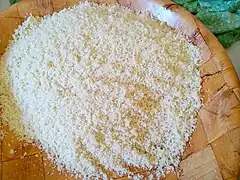
 Maize (corn)
Maize (corn)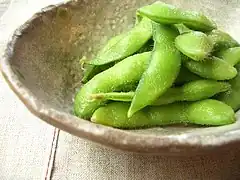

 Sorghum seeds and popped sorghum
Sorghum seeds and popped sorghum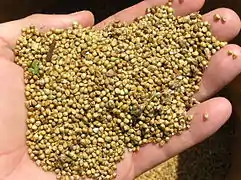 Millet grains
Millet grains
 Colored quinoa
Colored quinoa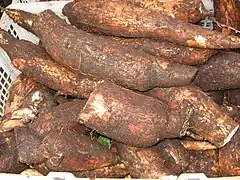 Cassava roots
Cassava roots
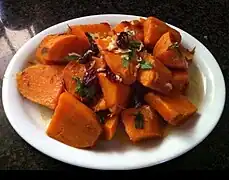 Sweet potato salad
Sweet potato salad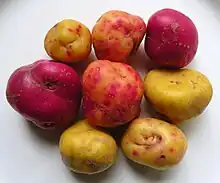 Ulluco tubers
Ulluco tubers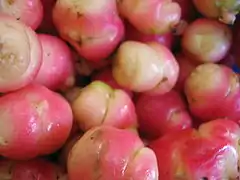 Oca tubers
Oca tubers Taro roots
Taro roots

See also
References
- 1 2 3 Su, Wen-Hao; He, Hong-Ju; Sun, Da-Wen (24 March 2017). "Non-Destructive and rapid evaluation of staple foods quality by using spectroscopic techniques: A review". Critical Reviews in Food Science and Nutrition. 57 (5): 1039–1051. doi:10.1080/10408398.2015.1082966. ISSN 1040-8398. PMID 26480047. S2CID 40398017.
- 1 2 United Nations Food and Agriculture Organization: Agriculture and Consumer Protection. "Dimensions of Need - Staples: What do people eat?". Retrieved 15 October 2010.
- ↑ "Around the world in dishes made with pulses". Food and Agricultural Organisation of the United Nations. 18 November 2015. Retrieved 23 September 2017.
- ↑ The Sago Palm: The Food and Environmental Challenges of the 21st Century. Kyoto University Press. 2015. p. 331. ISBN 978-1-920901-13-4.
- ↑ "African Food Staples". Retrieved 29 May 2015.
- ↑ "Olive Oil & Health - All Olive Oil". Retrieved 29 May 2015.
- ↑ "How Sugar Went From a Condiment to a Diet Staple". Time.
- ↑ "Dimensions of Need: An atlas of food and agriculture". Food and Agriculture Organization of the United Nations. 1995.
- ↑ E.A. Oelke; et al. "Quinoa". University of Minnesota.
- ↑ Arbizu and Tapia (1994). "Plant Production and Protection Series No. 26. FAO, Rome, Italy". FAO / Purdue University.
- ↑ John E. Foster. "Pemmican". The Canadian Encyclopedia. Archived from the original on 29 May 2015. Retrieved 29 May 2015.
- ↑ Allianz. "Food security: Ten Crops that Feed the World". Allianz.
- ↑ "Food and Agricultural commodities production / Commodities by regions". Food and Agriculture Organization of the United Nations. 2012. Archived from the original on 16 June 2016. Retrieved 7 January 2015.
- ↑ The numbers in this column are country average; regional farm productivity within the country varies, with some farms even higher.
- ↑ "FAOSTAT: Production-Crops, 2010 data". Food and Agriculture Organization of the United Nations. 2011.
- ↑ "Food and Agricultural commodities production / Countries by commodity (2013 data)". Food and Agriculture Organization of the United Nations. Retrieved 24 April 2016.
- ↑ "USDA Crop Production" (PDF). Retrieved 20 February 2022.
- ↑ United Nations Food and Agriculture Organization: Agriculture and Consumer Protection. "Rice and Human Nutrition" (PDF). Retrieved 15 October 2010.
- ↑ Wernick, Adam (29 October 2017). "Global warming threatens nutrition levels in staple crops". Public Radio International (PRI). Retrieved 30 October 2017.
- ↑ "Nutrient data laboratory". United States Department of Agriculture. Retrieved August 10, 2016.
External links
 Media related to Staple foods at Wikimedia Commons
Media related to Staple foods at Wikimedia Commons